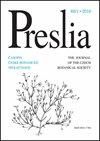相对DNA含量的差异可靠地鉴定了一枝黄花×niederederi,一种本地和外来入侵物种之间的杂交品种
IF 4.4
2区 生物学
Q1 PLANT SCIENCES
引用次数: 2
摘要
外来同系物与本地同系物的杂交可能对生物多样性造成严重威胁,并对本地植物区系造成负面影响。在这里,我们研究了一枝黄花×niederederi,它起源于欧洲,是外来的加拿大一枝黄花与本土一枝黄花杂交的结果。最近欧洲S. ×niederederi记录数量的增加突出表明有必要监测其发生、传播和行为。在本研究中,我们测试了流式细胞术检测S. ×niederederi杂交植株的有效性。利用nrDNA ITS区序列和cpDNA rpS15-ycf1间隔序列确认了所分析植物的杂交来源,并鉴定了母系物种。本研究包括来自中欧及邻近地区6个国家的加拿大藜、巨型藜和virgaurea藜的60个单种居群,以及含有×niederederi杂交种的16个混合居群。所调查的加拿大山杉树、×niederederi山杉树和virgaurea的个体均为二倍体(2n~2x~18),但相对DNA含量存在差异。S. ×niederederi的DNA含量介于S. canadensis和S. virgaurea之间,没有重叠,种间差异有统计学意义。因此,我们得出结论,流式细胞术是一种可靠而有效的方法,可以在混合的紫苏花群体中进行详细的杂交筛选,并鉴定不开花或形态模糊的紫苏花植物。由于两个亲本物种在DNA含量上的差异可以忽略不计,因此它也可能适用于更广泛的地理范围。遗传、流式细胞术和分布数据表明,这些杂交种在很大程度上是早期代(可能是F1)杂交种,因为也推断出了极少数假定的渐渗子。叶绿体rpS15-ycf1间隔区结果表明,杂交发生在两个方向。本文章由计算机程序翻译,如有差异,请以英文原文为准。
Relative DNA content differences reliably identify Solidago ×niederederi, a hybrid between native and invasive alien species
Hybridization between native and alien congeners may pose a serious threat to biodiversity and negatively affect native flora. Here we study Solidago ×niederederi, which originated and became established in Europe as a result of a cross between the alien S. canadensis and native S. virgaurea. The recent increase in the number of records of S. ×niederederi in Europe has highlighted the need to monitor its occurrence, spread and behaviour. In the present study, we tested the effectiveness of flow cytometry for detecting hybrid plants of S. ×niederederi. Sequences of the ITS region of nrDNA and the rpS15-ycf1 spacer of cpDNA were used to confirm the hybrid origin of analysed plants and to identify the maternal species. Our study included 60 single-species populations of S. canadensis, S. gigantea and S. virgaurea, and 16 mixed populations with the presence of hybrid S. ×niederederi sampled from six countries in central Europe and adjacent areas. All individuals of S. canadensis, S. ×niederederi and S. virgaurea investigated were diploid (2n~2x~18) but differed in their relative DNA content values. The DNA content of S. ×niederederi was intermediate between S. canadensis and S. virgaurea with no overlaps, with the differences between the species being statistically significant. Therefore, we conclude that flow cytometry is a reliable and efficient method for detailed screening for hybrids within mixed Solidago populations and for identifying non-flowering or morphologically ambiguous Solidago plants. Since both parental species varied only negligibly in their DNA content, it may also be applicable across a broader geographic scale. Genetic, flow cytometric and distributional data suggest that the hybrids are to a large extent early generation (likely F1) hybrids as very few cases of supposed introgressants were also inferred. The results from chloroplast rpS15-ycf1 spacer showed that hybridization has occurred in both directions.
求助全文
通过发布文献求助,成功后即可免费获取论文全文。
去求助
来源期刊

Preslia
生物-植物科学
CiteScore
5.20
自引率
29.40%
发文量
8
审稿时长
>12 weeks
期刊介绍:
Preslia is a peer-reviewed scientific journal publishing original research papers on plant systematics, morphology, phytogeography, ecology and vegetation science, with a geographical focus on central Europe. The journal was founded in 1914 and named in honour of brothers Jan Svatopluk Presl (1791–1849) and Karel Bořivoj Presl (1794–1852), outstanding Bohemian botanists. It is published quarterly by the Czech Botanical Society.
 求助内容:
求助内容: 应助结果提醒方式:
应助结果提醒方式:


